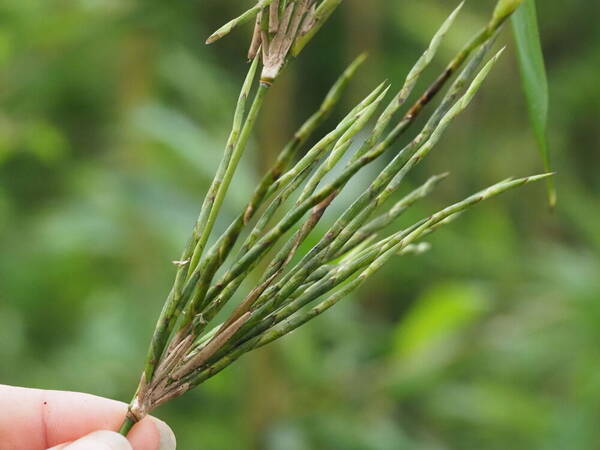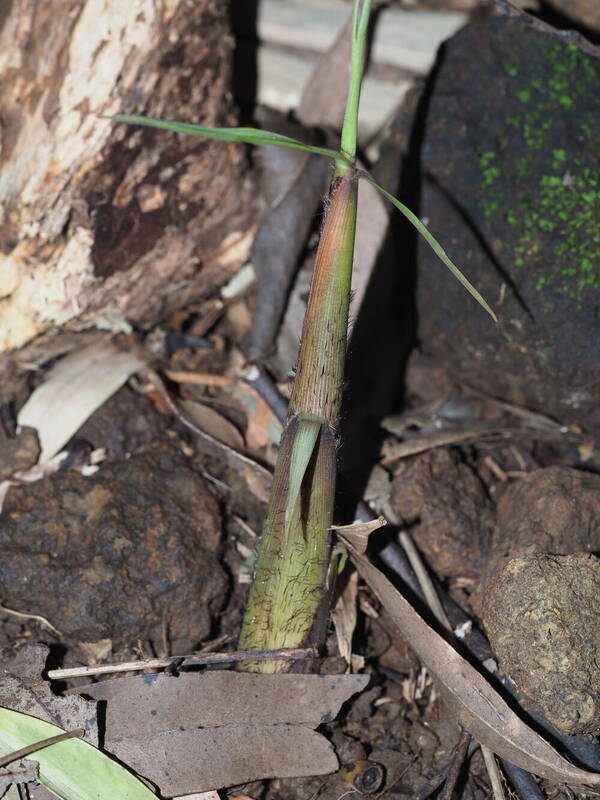Info
Subfamily: Bambusoideae
Genus etymology: Phyllostachys = "leaf spike" [Greek] refering to the lemmas having well developed blades
Species etymology: nigra = "black" [Latin] refering to the culms; henonis = honorific for Jacques Louis Hénon (1802–1872)
Photosynthetic type: C3 (cool season)
Nativity: naturalized - intentional
First recorded in Hawaiʻi: 1951
Map


Inflorescence



Plant


Habit

Spikelets



Landscape

Shoot



Description
Large perennials; culms green, woody, up to 80 dm tall, 3 cm in diameter, smooth to ribbed-striate, glabrous, internodes 7.5—20 (-32) cm long at base, fringed by a dense ring of purplish to brown hairs just above the node, nodal ridges moderately prominent, sheath scars as prominent as the nodal ridges, thin, flared, glabrous, but usually fringed with brown hairs; sheaths greenish brown to pale brown or pale reddish brown, usually sparsely pubescent with spreading, brown, erect hairs, margins overlapping, ciliate, auriculate, sheath blades broadly to narrowly triangular, boat-shaped wavy, increasingly so in larger culms, appressed to lower sheaths, spreading away from culm in the upper ones; ligule 1-2 mm long, chartaceous, margins rounded to truncate, erose; blades commonly up to 9(-13) cm long, up to 1.5(-2) cm wide, usually glabrous or nearly so, rarely the lower surface sparsely to densely pilose. Inflorescences racemose, enclosed within numerous bracts on short branches; spikelets enclosed in a narrowly ovate, glabrous, many-nerved, ciliate-margined bract, linear, up to 30 mm long, chartaceous to indurate, florets 2, first floret perfect, sessile, second floret sterile, pedicellate; glumes chartaceous, linear to narrowly ovate, 15-20 mm long, scabrous toward base, becoming more densely pilose toward summit, many-nerved, rounded on the back, apex acuminate, awned, the awn 1—1.5 mm long; first lemma chartaceous, linear, 2.7-3 mm long, evenly appressed pubescent, evenly to densely long-pilose toward summit, many-nerved, rounded on the back near base, keeled toward apex, apex long-acuminate, awned; first palea narrowly ovate, ca. 1.3 mm long, longitudinally grooved on abaxial margin where it comes in contact with the sterile, pedicellate floret, many-nerved, densely appressed pilose, margins inrolled slightly, apex long-acuminate, minutely bifid. Caryopsis not seen. [2n = 48, 54.)
(Description source: O’Connor, P.J. 1990. Poaceae, pp. 1481–1604. In: Wagner W.L., Herbst D.R. & Sohmer S.H. (eds.)., Manual of the flowering plant of Hawaiʻi. Vol. 2. University of Hawaii Press & Bishop Museum Press, Honolulu )